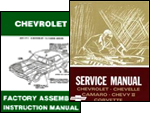|

| Dropped Spindles and Disc Brakes for 1958-70
Chevys |
| By Damon Lee |
|
|
| Any enthusiast who owns the same custom car for a significant
length of time is bound to refine it as he goes along. He builds the car,
drives it, determines its strengths and weaknesses and ideally, makes tweaks
to improve it through the years. The same can be said of aftermarket parts.
After selling the same component for years on end, a company is bound to
find ways to make it better. Sometimes the company makes minor design
tweaks and changes that slowly alter the part over time. In other cases,
it completely redesigns a component to give it more benefits and achieve
the desired results. Classic Performance Products has been building dropped
spindles for Chevy cars and trucks for many years now. Not surprisingly,
one of its more popular offerings has been a 2-inch dropped spindle for
1958-64 fullsize Chevy cars. |
The original spindle design worked fine and did what it was
supposed to in lowering the car, maintaining proper suspension geometry,
and allowing disc brakes. Yet recently the folks at CPP thought the spindle
design could be better,. so they went back to the drawing board to see what
they could develop. The result is an all-new design that is more versatile
and covers a wider range of applications; Cast from ductile iron and fitted
with CNC-machined, 4140 chrome-moly pins, the new spindle is designed to
deliver the same 2-inch drop as its predecessor. However, the new version
is designed to use your car's original steering arms, rather than having
the arm cast into the spindle. This means the spindle will not only work
on '58-64 cars, but will also fit '65-70 fullsize Chevys. Similarly, the
bolt-on caliper bracket design allows for a wider range of disc brake options. |
Speaking of brakes, if you have already upgraded to disc brakes
using your car's stock spindles, the rotors and calipers will likely fit
on these spindles. If you still need discs the spindles employ aluminum
hub assemblies that accept a variety of disc brake options. From factory
style 11-inch rotors and cast-iron calipers to larger 12- and 13-inch rotors
with big C-15 PBR-style calipers. Even better the hubs allow for easy rotor
swaps without having to mess with grease or bearings. To give
you a better look at this new spindle we followed along as Jeff Wise at
CPP installed a pair on a '62 Impala. Take a look and see what you think. |
 |
| 1. The hardest thing about almost any spindle or brake swap
can be breaking loose the old parts, particularly the ball joints. The best
method is usually swinging a hammer where the ball joint stud mounts to
the spindle. Note that the castle nut is still in place to keep the suspension
from springing apart; it's also smart to have a jack or other form of support
under the lower control arm at this point. |
|
 |
| 2. Jeff felt confident allowing the shock to hold the coil
spring and lower control arm together. Again, we would have employed a spring
compressor or some form of support under the control arm as extra security
to keep the spring from papping free. Regardless, the original spindle and
drum brake assembly came off easily after breaking the ball joints and tie-rod
ends loose. |
|
 |
| 3. A comparison of the CPP spindle {left} and stock spindle
shows the higher pin, but otherwise similar design. |
|
 |
| 4. This is always a good time to swap in new ball joints if
necessary. This car didn't need them, so the new spindle was simply bolted
in place and torqued to the proper specs. |
|
 |
| 5. The new spindle design utilizes bolt-on caliper brackets,
which allows CPP to offer several styles and sizes of brake packages. |
|
 |
6-7. The aluminum hub assemblies feature roller bearings and
come pre-greased and sealed. Just unwrap one, slide it onto the
spindle, secure with the supplied nut, and tap on a dust cap. |
|
 |
| 8-9. The vehicle's stock steering arms bolt in place using
the supplied countersunk Allen-head bolts, which are necessary to provide
adequate clearance for the brake rotors. |
|
 |
| 10. Several different rotor options can be had with the spindles.
On this application, the owner opted for the style and performance of 13-inch
drilled, slotted, and zinc-washed rotors. |
|
 |
| 11. A couple of different caliper options are also available.
The 12-inch rotor kit uses 1970-77 Camaro calipers, while the larger rotors
employ these PBR calipers designed for C-10 pickups, which use twin 52mm
pistons and can be had in a polished or standard black finish. |
|
 |
| 12. Once loaded with brake pads, the calipers simply bolt
to their brackets using the supplied hardware. |
|
 |
| 13. With any brake upgrade, it's wise to replace the cracked,
original brake hoses with fresh versions like these, which were supplied
with the brake package. You'll also want to install a disc brake master
cylinder that's up to the task of actuating your new binders. |
|
 |
 |
| 14-15. Here's the finished install, from both the front and
rear sides. All in all, it was a pretty simple swap that should stop even
better than it looks. |
|
 |
| It's always best to have shop and assembly manuals on hand
to make sure your installation is correct and to make the project as easy
as possible. We recommend factory manuals, available at Greg's
Automotive |
|
|
|


